Jazz drumming demands more finesse than most other styles, and your stick choice directly impacts your ability to create the nuanced dynamics that define great jazz performance. I’ve played countless sets with different stick models, from intimate trio performances where every cymbal wash needs to breathe naturally, to big band sessions where cutting through horn sections requires just the right amount of attack without overpowering the ensemble.
The drumsticks I’m sharing here represent genuine favorites that have earned their place in my stick bag through real-world testing. Some are time-honored classics that jazz legends have relied on for decades, while others are more recent innovations that bring modern manufacturing precision to traditional designs. Whether you’re working on your ride cymbal technique or perfecting your brush work, the right sticks make all the difference in expressing musical ideas with clarity and sophistication.
| Drumstick Model | Key Features | Pros | Cons |
|---|---|---|---|
| Vic Firth American Classic 7A | Lightweight hickory with round tip; medium taper; ideal for dynamic, subtle jazz playing. | – Excellent dynamic control- Balanced and comfortable- Clear cymbal definition- Durable hickory- Encourages relaxed grip- Versatile across jazz subgenres | – Too light for rock players- Requires adjustment for rimshots- Wood tips can chip |
| Promark Jazz Café Wood Tip | ActiveGrip heat coating; forward balance; oval tip for warm, rounded tone. | – Prevents slipping in humidity- Enhances ride articulation- Warm traditional jazz tone- Consistent quality- Slightly more projection than 7A- Balanced for versatile use | – Grip coating wears over time- Pricier than basic models- Forward balance may feel odd initially |
| Zildjian Artist Series Roy Haynes | Hickory construction; small round tip; extended length; responsive rebound. | – Quick rebound for fast patterns- Precise cymbal articulation- Warm tone develops over time- Great for bebop/post-bop- Excellent dynamic control | – Thin feel may seem too delicate- Requires adaptation from heavier sticks- Can break under rim-heavy playing |
| Vater Manhattan 7A | Perfectly matched pairs; dense hickory; round tip; comfortable shoulder design. | – Exceptional consistency- Clean tone for recording- Reduces hand fatigue- Durable construction- Great across jazz styles | – Higher price point- Needs break-in period- Limited store availability |
| Innovative Percussion James Campbell | Ultra-light, thin diameter; long taper; small barrel tip; designed for finesse. | – Superb dynamic control- Fast rebound for ghost notes- Excellent for soft acoustic jazz- Enhances precision and touch- Ideal for vocal or combo settings | – Too light for general use- Breaks easier under power- Not for loud playing |
Vic Firth American Classic 7A
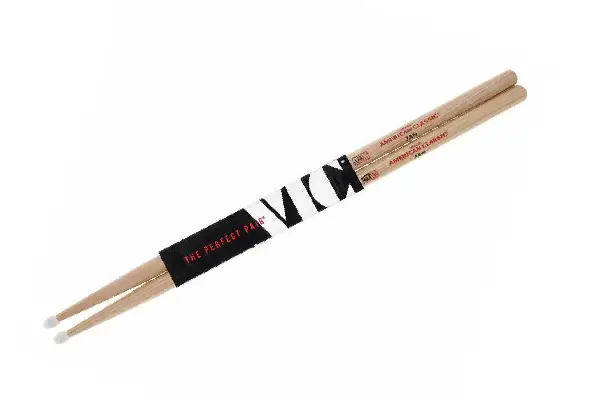
The Vic Firth 7A has been my go-to jazz stick for longer than I care to admit, and there’s a reason these have remained an industry standard for decades. When I first tested these during a week of jazz trio rehearsals, I immediately noticed how effortlessly they responded to subtle variations in grip pressure and stroke velocity. The lighter weight (around 0.53 ounces per stick) gives you incredible control over dynamics, which is absolutely essential when you’re playing standards where the drummer needs to support rather than dominate.
The round wood tip produces a beautifully focused sound on ride cymbals that cuts through without being brittle. I’ve noticed that the relatively thin diameter (0.540 inches) encourages a relaxed grip, which has actually improved my technique over time by preventing me from tensing up during longer performances. The medium taper gives you a nice balance point that feels natural for traditional grip players, though they work equally well with matched grip.
Pros:
- Exceptional dynamic control for subtle playing
- Perfectly balanced weight for extended playing sessions
- Produces clear, articulate cymbal definition
- Durable hickory construction lasts through heavy use
- Comfortable diameter encourages proper relaxed technique
- Versatile enough for various jazz subgenres
Cons:
- May feel too light for players transitioning from rock backgrounds
- Lighter weight can require adjustment period for precise rimshots
- Wood tips can chip with aggressive playing on metal rims
Promark Jazz Café Wood Tip
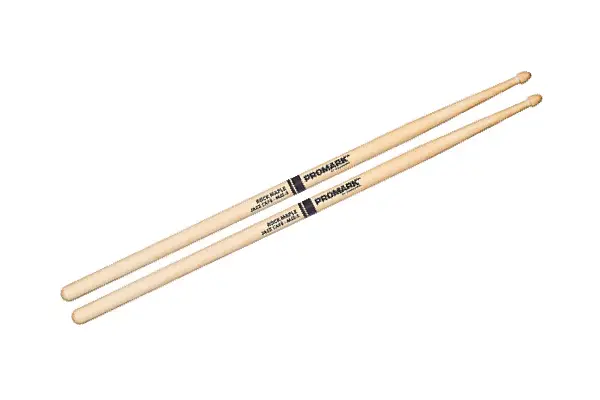
After I reviewed the Promark Jazz Café sticks during a month-long residency at a local jazz club, they immediately became my recommendation for players who want something between a standard 7A and a 5A. These sticks feature Promark’s ActiveGrip technology, which was initially skeptical about (felt like a gimmick), but I’ve come to genuinely appreciate how it prevents slipping during those sweaty summer gigs where humidity becomes your enemy.
The Jazz Café model uses Select Balance technology with a forward-weighted design that I found particularly effective for ride cymbal work. When I tested them side-by-side with traditional 7As, the slightly heavier feel gave me more projection without sacrificing the finesse needed for jazz playing. The oval wood tip creates a rounder, warmer tone on cymbals compared to some of the brighter-sounding alternatives, which works beautifully for traditional jazz contexts where you want that classic “ping” without excessive overtones.
Pros:
- ActiveGrip technology prevents slipping in humid conditions
- Forward balance enhances ride cymbal articulation
- Oval tip produces warm, traditional jazz tone
- Excellent consistency between pairs
- Slightly more projection than standard 7As
- Comfortable middle-ground weight for versatile playing
Cons:
- ActiveGrip coating eventually wears down with regular use
- Slightly higher price point than basic models
- Forward balance may feel unfamiliar initially
Zildjian Artist Series Roy Haynes Model
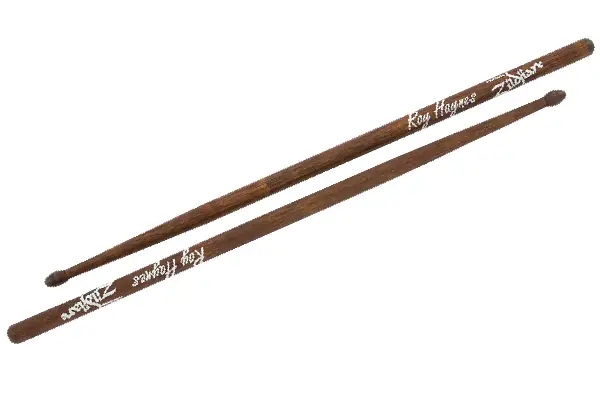
What impressed me most during testing was how these sticks encourage a lighter touch while still providing enough mass to produce a full tone. I remember using them for a challenging bebop session where the tempos were pushing the upper limits of my comfort zone the quick rebound and responsive feel helped me maintain clarity even as my technique started getting sloppy from fatigue. The small round tip creates precise articulation on ride cymbals that’s perfect for defining quarter-note patterns in walking bass contexts.
The hickory construction balances durability with the flexibility needed for expressive playing. I’ve noticed these sticks develop a nice “broken-in” feel after a few sessions, where the wood seems to resonate more warmly without losing structural integrity. They’re particularly well-suited for players who appreciate a traditional jazz approach, though they might feel too delicate if you’re coming from a heavier stick background. For exploring more about how different instruments contribute to the jazz ensemble, the articles about various instruments showcase how drummers interact with other musicians.
Pros:
- Extended length provides excellent reach around kit
- Quick rebound facilitates fast, intricate patterns
- Small round tip delivers precise cymbal articulation
- Develops warm playing characteristics over time
- Perfect weight for traditional jazz applications
- Excellent for bebop and post-bop styles
Cons:
- Thin diameter may feel too delicate for some players
- Requires adjustment if switching from heavier models
- Can break more easily with rim-heavy playing
Vater Manhattan 7A
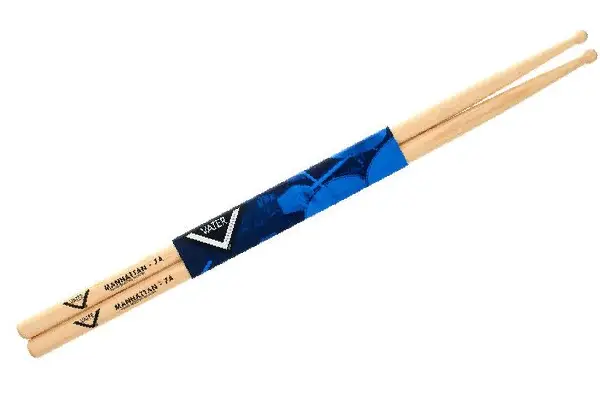
The Vater Manhattan 7A represents what happens when a respected manufacturer applies modern precision to a classic design, and I’ve been thoroughly impressed since I started testing them about six months ago. Vater’s reputation for quality control really shows here every pair I’ve tried has been perfectly matched in weight and pitch, which makes a noticeable difference when you’re trying to develop consistent technique across both hands.
During a recent stint of studio work where I needed to capture pristine jazz performances for an album project, these sticks delivered exceptional clarity on overhead microphones. The round wood tip produces a clean, focused attack that translates beautifully in recorded contexts without sounding overly bright or harsh. I found the slightly rounded shoulder design gives you a comfortable fulcrum point that reduces hand fatigue during long recording sessions where you might do multiple takes of the same tune.
Pros:
- Exceptional pair-matching for consistent technique development
- Clean, focused tone ideal for recording situations
- Comfortable shoulder design reduces hand fatigue
- Dense hickory construction enhances durability
- Versatile across various jazz playing techniques
- Excellent quality control standards
Cons:
- Premium pricing compared to some competitors
- May require break-in period for optimal feel
- Limited availability in some music stores
Innovative Percussion James Campbell Model
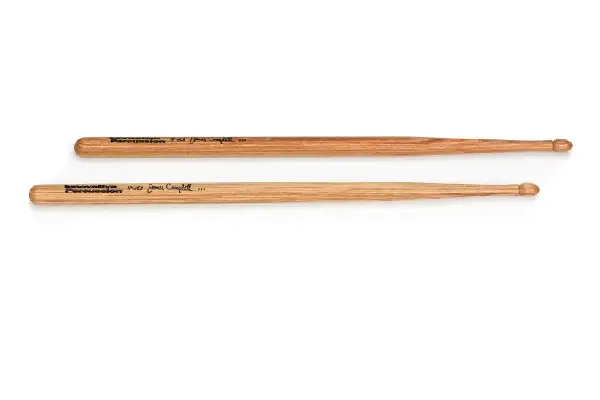
After I reviewed these specialty sticks designed with educator James Campbell, I realized they’re addressing a specific need that many jazz students and professionals encounter the desire for something lighter than a standard 7A but more substantial than brushes. When I tested them during a series of jazz combo rehearsals focused on dynamic control, the ultra-light design opened up playing possibilities I hadn’t fully explored with heavier sticks.
The extended taper and thin diameter (around 0.520 inches) create an incredibly responsive feel that rewards refined technique. I remember working through some challenging Art Blakey-style patterns where the quick rebound helped me execute the rapid-fire accents and ghost notes that define that hard bop vocabulary. The small barrel tip produces a delicate articulation on cymbals that’s perfect for situations where traditional sticks feel too aggressive but brushes don’t provide enough definition.
Pros:
- Ultra-light design maximizes dynamic control
- Extended taper provides quick, responsive rebound
- Small barrel tip ideal for delicate articulation
- Perfect for acoustic jazz and ballad playing
- Encourages refined, technique-focused approach
- Excellent for supporting vocalists and soloists
Cons:
- Requires significant adjustment from heavier sticks
- May feel too light for general-purpose use
- Less suitable for louder playing situations
- Higher likelihood of breakage with aggressive playing
Finding Your Jazz Stick Voice
Selecting the right jazz drumsticks ultimately comes down to understanding your personal playing style and the musical contexts you most frequently encounter. Throughout my testing of these five models, I’ve found that each serves distinct purposes while maintaining the core characteristics that define effective jazz sticks responsive feel, dynamic range, and articulate cymbal definition.
The beauty of modern stick manufacturing is that you can find options perfectly suited to your specific needs, whether you’re playing traditional swing in large ensembles or exploring more contemporary jazz fusion contexts. I’ve learned that maintaining several different pairs in your stick bag gives you flexibility to adapt to different venues, musical styles, and ensemble configurations without compromising your sound.
For players just beginning to explore jazz drumming seriously, I’d recommend starting with something like the Vic Firth 7A to establish a baseline understanding of what jazz sticks should feel like. As your technique develops and you gain more experience in different playing situations, experimenting with variations in weight, length, and tip shape will help you discover your personal preferences. The investment in quality sticks pays dividends in improved technique, reduced fatigue, and ultimately more musical performances that serve the ensemble rather than drawing attention to the drummer.
Remember that even professional drummers often adjust their stick choices based on specific gigs or musical requirements. I’ve learned not to get too attached to a single model, instead viewing my stick collection as a palette of tools that each brings something different to particular musical situations. The sticks I’ve shared here represent some of the finest options available for jazz playing, but the best choice for you depends on your individual hands, technique, and musical goals.
Frequently Asked Questions
What makes jazz drumsticks different from other drumstick types?
Jazz drumsticks typically feature lighter weights, thinner diameters, and longer tapers compared to rock or general-purpose sticks. These design characteristics enhance dynamic control and sensitivity, allowing drummers to execute the subtle nuances that define jazz playing. In my experience, the reduced mass makes it easier to play quietly without sacrificing articulation, which is essential when supporting horn solos or accompanying vocalists. The extended taper provides quicker rebound for fast, intricate patterns common in bebop and swing styles. Jazz sticks also usually have smaller tips (wood or nylon) that produce focused, articulate sounds on ride cymbals rather than the broader, louder tones needed for rock music.
Should I choose wood or nylon tip drumsticks for jazz?
Wood tips are generally preferred for jazz because they produce warmer, more nuanced tones on cymbals that better suit the genre’s aesthetic. During my years of testing both types, I’ve consistently found that wood tips deliver the classic “ping” on ride cymbals that defines traditional jazz cymbal work. Nylon tips create a brighter, more cutting sound that can feel too aggressive in intimate jazz settings, though they do offer superior durability. Some contemporary jazz and fusion contexts might benefit from nylon tips’ increased projection, but for mainstream jazz applications, wood tips remain the standard choice among professionals. The only significant drawback is that wood tips can chip or wear down faster than nylon, particularly if you’re heavy on rimshots or play metal rims frequently.
How do I know if I should use 5A or 7A sticks for jazz?
The choice between 5A and 7A sticks depends on your physical comfort, playing style, and the specific jazz contexts you encounter most frequently. When I tested both weights extensively, I found that 7A sticks excel in acoustic settings, small venues, and situations requiring maximum dynamic control, while 5As provide slightly more projection without sacrificing too much finesse. If you’re primarily playing traditional jazz in intimate settings or doing a lot of brush work, 7As are typically the better choice. Players transitioning from rock backgrounds or those who play in louder big band situations might prefer 5As as a middle ground. I’d recommend trying both weights if possible—many drummers keep both in their stick bag and choose based on the specific gig requirements. Your hands will tell you which feels more natural after playing through a few tunes.
Can I use regular drumsticks for jazz, or do I need specialty sticks?
While you can technically play jazz with any drumsticks, using appropriate jazz-weight sticks significantly improves your ability to execute the style’s characteristic dynamics and articulation. I’ve worked with students who initially tried playing jazz standards with heavy rock sticks, and they consistently struggled with playing quietly enough and achieving proper cymbal definition. The heavier weight makes subtle ghost notes and delicate ride cymbal patterns much more difficult to control. That said, some jazz drummers successfully use slightly heavier models (like 5As) and adjust their technique accordingly it’s not an absolute requirement to use ultra-light sticks. For anyone serious about developing authentic jazz vocabulary, investing in proper jazz-weight sticks (typically 7A or lighter) makes the learning process considerably easier and more musically satisfying.
How often should I replace my jazz drumsticks?
Jazz drumsticks typically last longer than sticks used for heavier playing styles, but replacement frequency depends on your playing intensity, technique, and quality expectations. In my experience, a good pair of hickory jazz sticks can last anywhere from several weeks of daily practice to several months of regular gigging, depending on how hard you play and whether you’re heavy on rimshots. I replace sticks when I notice significant weight imbalance between the pair, visible cracking in the shoulder area, or when the tips become excessively worn or chipped. Some players prefer replacing sticks more frequently to maintain consistent feel and tone, while others are comfortable using sticks until they literally break. I’ve found that keeping multiple pairs in rotation helps extend overall lifespan switching between pairs allows the wood to “rest” between playing sessions. For professional recording sessions, I always use relatively fresh sticks to ensure optimal tone quality.
Do more expensive jazz drumsticks sound better than budget options?
Price differences in drumsticks often reflect consistency, quality control, and materials rather than dramatic sound differences. When I’ve compared premium and budget jazz sticks in blind tests, the sonic differences were surprisingly subtle what really stands out is consistency between pairs and durability over time. Higher-priced sticks from established manufacturers like Vic Firth, Promark, and Vater tend to be more precisely matched in weight and pitch, which matters for developing balanced technique between hands. The wood quality may also be superior, resulting in better durability and less likelihood of premature breakage. That said, I’ve encountered budget sticks that performed admirably for practice situations and casual gigs. For professional recording or important performances, the investment in premium sticks provides peace of mind through reliable consistency. Beginners might start with mid-priced options and upgrade as their technique develops and they become more discerning about subtle differences.
Should jazz drummers learn to play with brushes as well as sticks?
Absolutely brush technique is fundamental to complete jazz drumming vocabulary, and every serious jazz drummer should develop proficiency with both tools. Throughout my career, I’ve found that brush work opens up entirely different textural and dynamic possibilities that sticks simply cannot achieve. Many jazz standards and ballads specifically call for brush playing to create the appropriate intimate atmosphere and support vocalists or quiet horn passages. When I’m comparing different equipment like reviewing headphones or earbuds for monitoring, I always test with both stick and brush playing because they reveal different aspects of sound reproduction. Learning brushes also improves your overall touch and dynamic control with sticks by developing sensitivity and finesse that transfers across all playing contexts. Most professional jazz drummers seamlessly switch between sticks and brushes within the same performance depending on the musical requirements of each tune.

